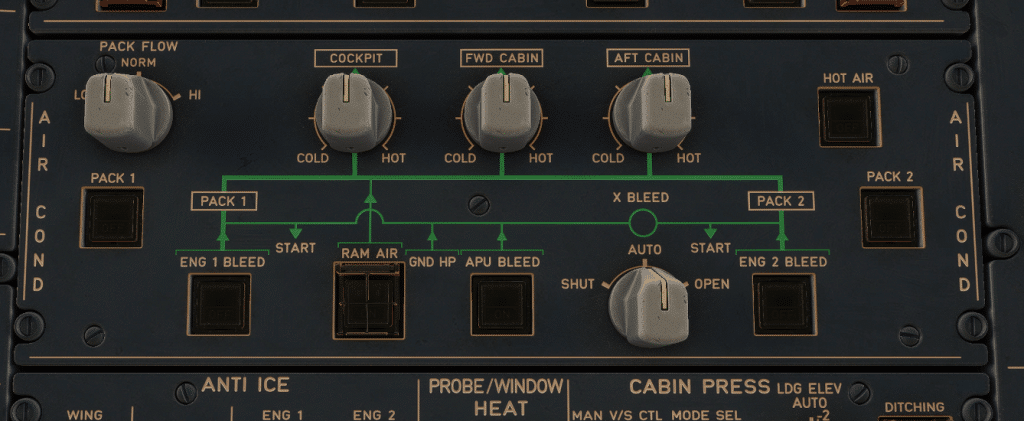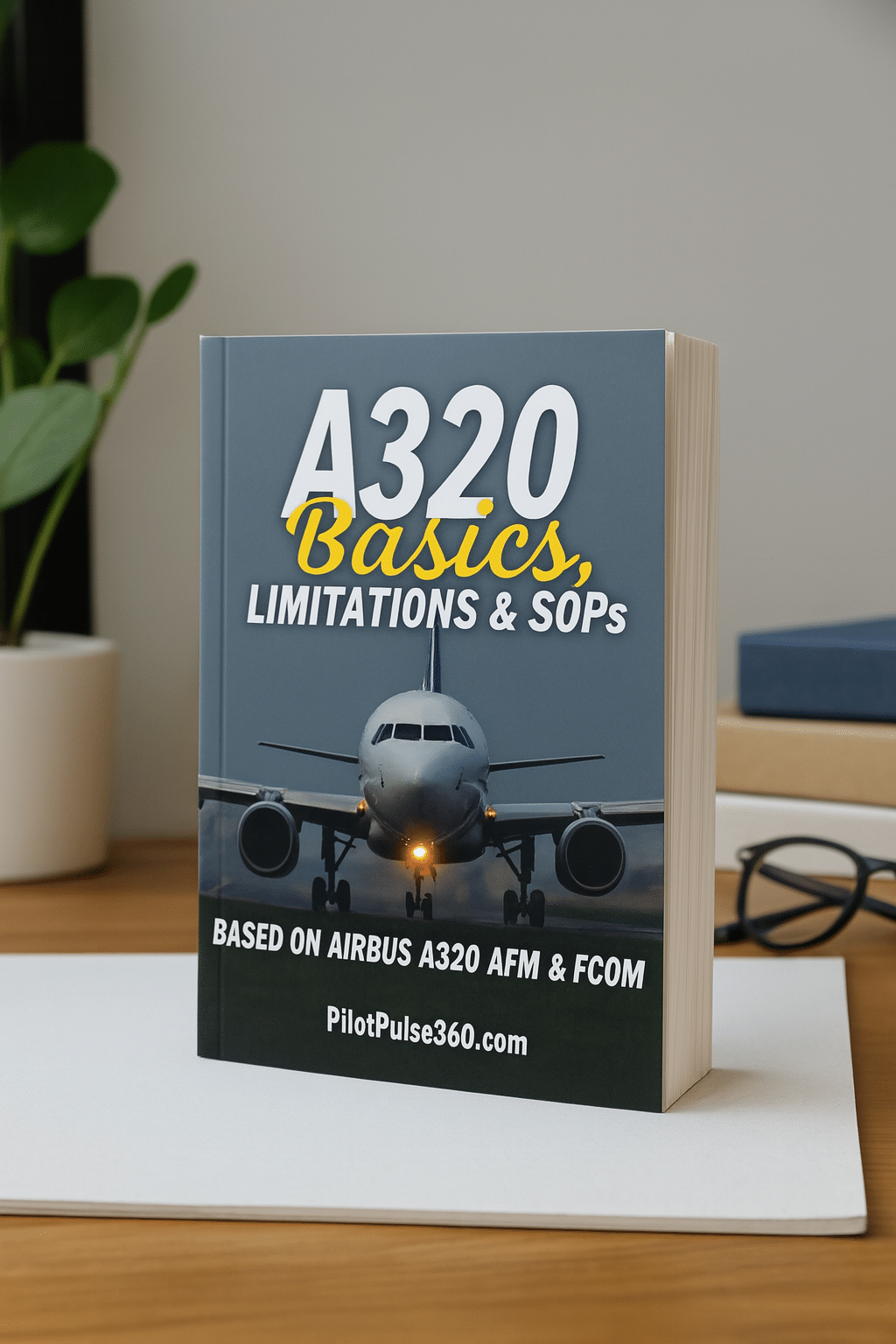Air Conditioning, Airbus A320
Understanding the A320 Temperature and Flow Regulation System
How Airbus manages air conditioning, flow control, and passenger comfort?
Maintaining precise cabin temperature and airflow across different zones of an aircraft is a complex engineering challenge. In the Airbus A320 family, this task falls to the Environmental Control System (ECS), which efficiently ensures thermal comfort, air quality, and pressurization throughout every phase of flight.
According to the Airbus A320 FCOM, the ECS continuously renews cabin air and regulates temperature across three independently controlled zones:
- Cockpit (Flight Deck)
- Forward Cabin
- Aft Cabin
Each zone operates independently, which allows for precise comfort management and optimal airflow distribution. This approach combines advanced automation with practical human control, a hallmark of Airbus engineering.
The Role of the Environmental Control System (ECS)
The ECS performs several vital functions. It regulates air temperature, manages airflow, and controls cabin pressurization and ventilation. Together, these subsystems maintain a comfortable and safe cabin environment for passengers and crew.
While pressurization protects cabin altitude, temperature and flow regulation primarily influence comfort. The A320 accomplishes this by blending bleed-air conditioning, trim-air control, and automatic pack-flow management. The Air Conditioning System Controller (ACSC) coordinates these processes seamlessly. As a result, the crew simply selects target temperatures, and the system automatically computes pack flow, trim-air valve position, and the optimal mix of fresh and recirculated air.
Air Supply: The Foundation of Temperature Control
The A320 sources bleed air from the engine compressor stages. This hot, pressurized air passes through the air conditioning packs, where it cools, dehumidifies, and conditions before being distributed throughout the aircraft.
Each pack includes the following components:
- A flow control valve that regulates bleed-air input
- An air cycle machine (ACM) that performs cooling
- A ram-air heat exchanger that removes heat
- A water extractor that removes moisture
Two identical packs work in parallel, sharing the load equally. Afterward, the system blends the pack outlet air in a mixing unit with recirculated cabin air, typically around 40–60% of the total airflow. This design not only enhances comfort but also improves energy efficiency.
Temperature Regulation: Trim-Air Logic
After the air mixes, the ECS fine-tunes each zone’s temperature using trim-air valves. These valves add a controlled amount of hot trim air (a portion of uncooled bleed air) to the zone ducts. The ACSC constantly compares each zone’s sensor reading to its selected setpoint and adjusts the valve accordingly. As a result, the temperature remains steady—usually within one degree of the selected value.
However, when trim air becomes unavailable due to a system or bleed fault, the ECS switches to pack outlet control. In this mode, all zones share a uniform temperature, maintaining comfort even during degraded conditions.
Flow Regulation and Efficiency Management
Airflow in the A320 adapts automatically to changes in cabin load and environmental conditions. The pack flow control valves adjust based on pack outlet temperature, system configuration, and the PACK FLOW selector on the overhead panel. This selector allows the crew to influence efficiency when necessary:
- LO: Reduces flow for lighter passenger loads or cool weather
- NORM: Standard setting for regular operations
- HI: Increases flow for hot, humid, or high-density conditions
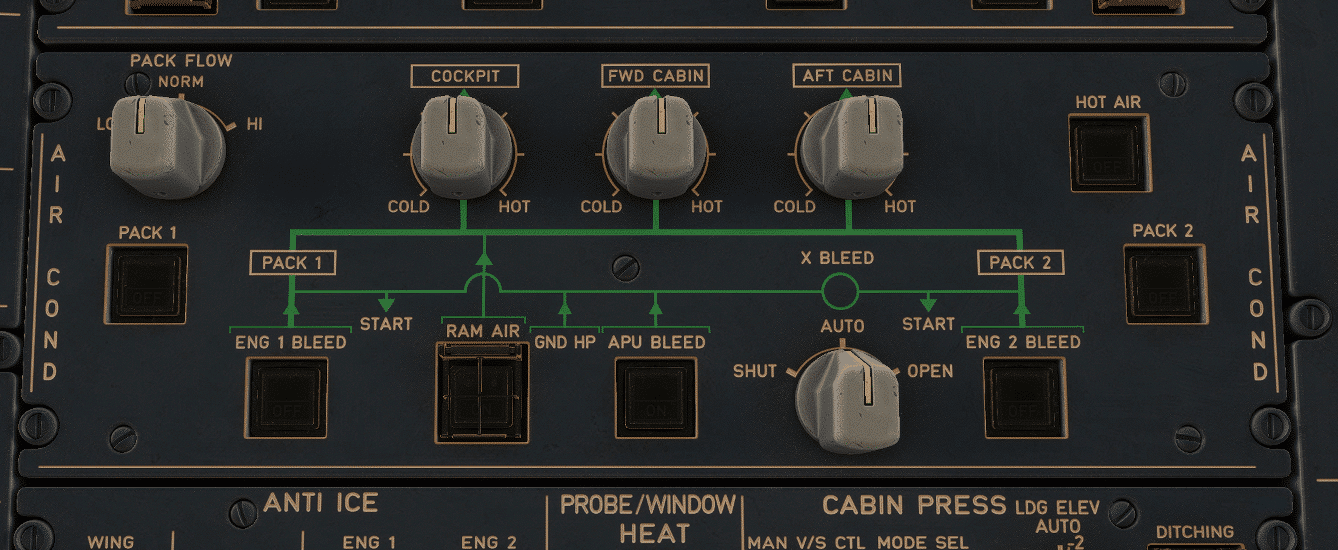
If one pack fails, the remaining pack automatically increases its flow to maintain proper ventilation. Therefore, cabin comfort remains stable even with reduced system capability.
Cabin Air Mixing and Recirculation
The mixing unit beneath the cabin floor combines conditioned pack air with recirculated air driven by fans. This design reduces bleed demand and improves overall efficiency. Typically, the cabin air refreshes every two to three minutes, ensuring a healthy oxygen balance and pleasant humidity levels.
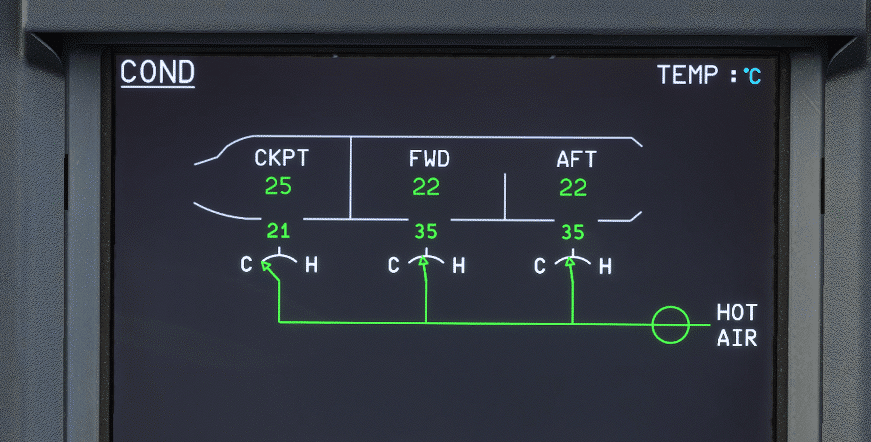
Under normal conditions, both recirculation fans operate continuously. However, if smoke is detected or a related failure occurs, the affected fan automatically stops to prevent contamination.
Control and Indication in the Flight Deck
The ECS requires very little pilot management, yet full system awareness remains available through the flight deck controls and ECAM displays. The AIR COND panel provides direct control of each cabin zone and key system functions, allowing the crew to manage or monitor the system effortlessly.
- Temperature Selectors: Independent knobs for the Cockpit, Forward Cabin, and Aft Cabin, allowing separate temperature targets.
- PACK FLOW Selector: Manual airflow selection (LO/NORM/HI) to influence flow rate and system efficiency.
- PACK Pushbuttons: Allow the crew to manually isolate or restore each pack.
- HOT AIR Pushbutton: Controls the trim-air valve, enabling or isolating hot-air supply for zone temperature regulation.
Pilots monitor ECS performance via the ECAM COND page, which displays:
- Zone and pack outlet temperatures
- Valve positions (packs, trim air, isolation)
- Recirculation fan status
- Pack flow indicators
During normal operations, the system functions automatically, requiring no crew input. However, when a fault occurs, ECAM provides a clear message and directs the crew through corrective actions. Two of the most common ECS alerts are PACK 1(2) FAULT and HOT AIR FAULT.
PACK 1(2) FAULT
This alert indicates that one of the air-conditioning packs has either failed or been shut down automatically due to an abnormal condition. According to the Airbus A320 FCOM (ATA 21-10), typical causes include pack overheat, compressor overpressure, or flow control valve malfunction.
| Condition | System Response | Crew Action (per ECAM) |
|---|---|---|
| Pack overheat or overpressure | The affected pack automatically shuts down and the FAULT light illuminates. | Set the pack OFF; after cooling, ECAM may direct the crew to reattempt ON if conditions permit. |
| Pack control or valve failure | The faulty pack remains OFF; airflow from that side ceases. | Operate with the remaining pack; set PACK FLOW = HI to maintain adequate cabin ventilation. |
- The remaining pack automatically increases flow to sustain cabin conditions.
- Pressurization control adjusts automatically for single-pack operation.
- Cabin temperature remains stable via trim-air compensation.
HOT AIR FAULT
The HOT AIR FAULT alert indicates that the trim-air pressure regulating valve has closed automatically, usually following a duct overheat or valve malfunction. This isolation prevents further temperature rise or smoke risk in the trim-air manifold.
| Condition | System Response | Operational Effect |
|---|---|---|
| Trim-air duct overheat or valve failure | The HOT AIR valve closes automatically; the ECAM message and panel FAULT light illuminate. | All cabin zones revert to the same pack outlet temperature; independent zone control is lost. |
- The ECS continues supplying conditioned air using only the pack outputs.
- Crew normally leaves the trim-air valve OFF until maintenance clearance.
- Cabin comfort remains within acceptable limits, though zone differentiation is unavailable.
Both of these alerts are handled by standard ECAM procedures and do not require immediate diversion unless accompanied by additional faults such as smoke, pressurization issues, or dual pack failure. The system’s redundancy and logic ensure continued comfort and safety even with one component inoperative.
Redundancy and Failure Management
Airbus designs its systems to continue operating effectively even when components fail. If one pack fails, the other automatically compensates. When a trim-air fault occurs, the ECS aligns zone temperatures to maintain overall comfort. Likewise, if one recirculation fan fails, the other continues operating to ensure airflow. Pilots can also manually isolate faulty components to protect the rest of the system.
In the rare case that both packs fail, cabin temperature and pressure will start to rise. In such circumstances, the ECAM directs the crew to descend and initiate smoke or pack-off procedures. The logic prioritizes safety while maintaining acceptable comfort levels.
Operational Insights
During normal operations, flight crews typically leave the ECS in automatic mode. The Flight Crew Techniques Manual explains that allowing the system to manage itself produces more stable results and reduces workload. Manual adjustments should only occur when operationally justified.
For instance, during single-engine taxi, crews may use a lower pack flow to conserve bleed air and fuel. In smoke or fumes procedures, airflow adjustments help remove contaminants. Likewise, when the aircraft dispatches under MEL with one pack inoperative, pilots select HI flow to maintain ventilation.
Design Philosophy and Passenger Comfort
Airbus designed the ECS to emphasize automation, reliability, and efficiency. The closed-loop control ensures temperature stability, while optimized flow logic minimizes bleed demand and reduces fuel burn. These features collectively enhance passenger comfort and operational performance.
In comparison with earlier designs, the A320 system requires fewer manual inputs, offers faster temperature recovery, and maintains consistent airflow distribution even during rapid environmental transitions. Consequently, both passengers and crew benefit from a calmer, more comfortable flight environment.
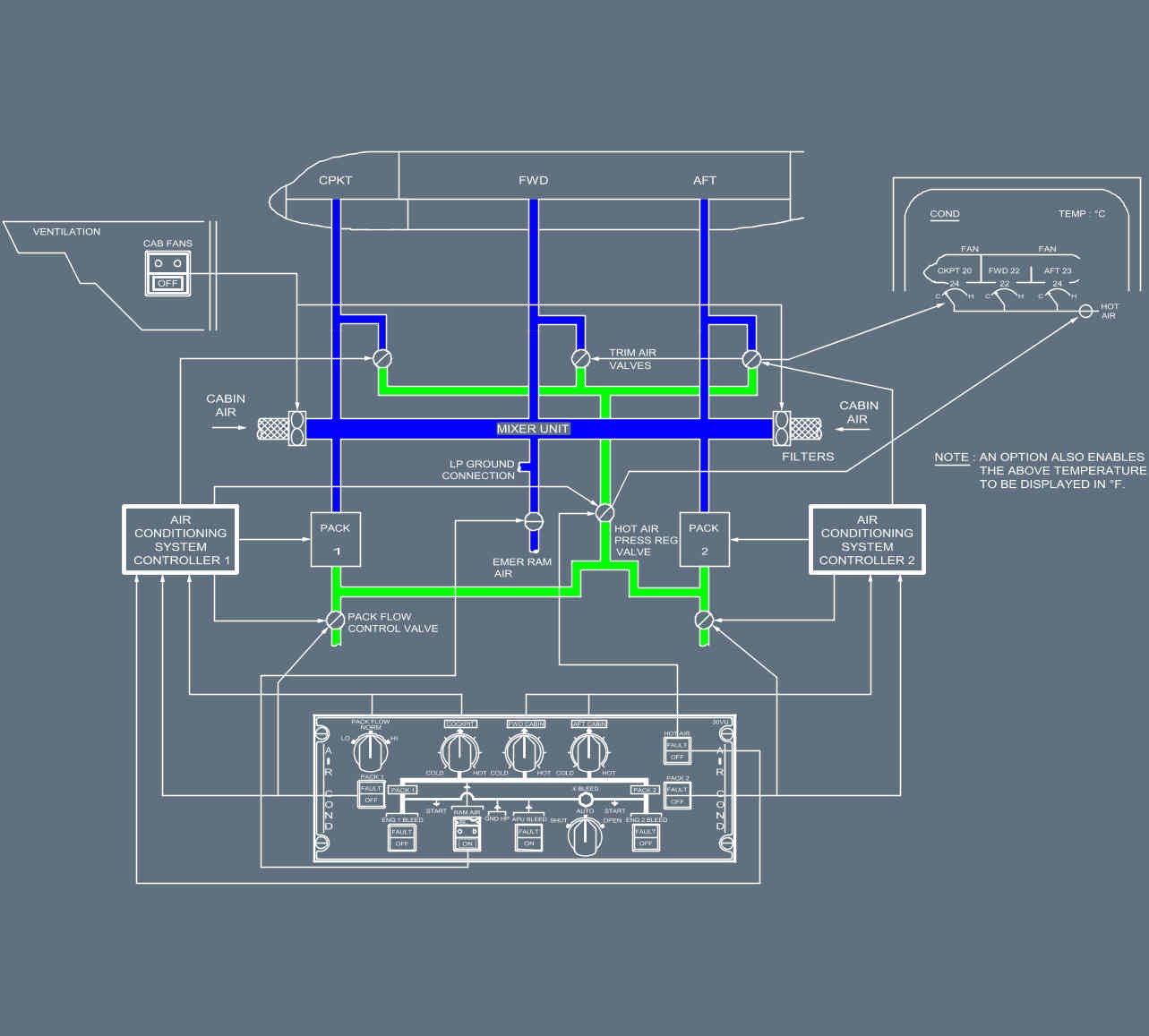
Final Insight
According to the A320 FCOM and the AFM, automatic temperature and flow regulation across three zones—using coordinated pack control, trim-air modulation, and pack-flow selection—reflects the Airbus philosophy of intelligent automation. This design reduces pilot workload, optimizes performance, and ensures comfort for everyone on board. In daily operations, the ECS performs its role so smoothly that crews rarely think about it, which demonstrates how effectively it does its job.
Frequently Asked Questions about the A320 Temperature and Flow Regulation System
What is the Environmental Control System (ECS) on the A320?
The A320’s Environmental Control System (ECS) regulates cabin temperature, airflow, and pressurization across three zones—cockpit, forward cabin, and aft cabin. It ensures thermal comfort, clean air, and proper cabin pressure during all flight phases.
How does the A320 regulate cabin temperature?
The A320 maintains temperature using two air conditioning packs, trim-air valves, and automated flow control. The system mixes bleed air and recirculated air while the Air Conditioning System Controller (ACSC) fine-tunes temperatures automatically for each cabin zone.
What is trim-air and how does it affect temperature control?
Trim-air is a controlled amount of hot bleed air added to the conditioned air stream. It allows precise temperature adjustment for each zone, ensuring passenger comfort and consistent thermal stability throughout the cabin.
What do the PACK FLOW settings (LO, NORM, HI) mean on the A320?
PACK FLOW settings adjust the amount of conditioned air delivered to the cabin. LO reduces flow for light loads or cool conditions, NORM is used during normal operations, and HI increases flow for hot or high-density environments.
What happens if one air conditioning pack fails on the A320?
If one pack fails, the remaining pack automatically increases airflow to maintain ventilation and comfort. This redundancy ensures stable cabin conditions even with reduced system capability.
About Airbus ECS
The temperature and flow regulation system in the Airbus A320 is part of the aircraft’s Environmental Control System (ECS), designed and developed by Airbus to maintain optimal cabin comfort, air quality, and pressurization across all flight phases.
For detailed system information and official specifications, refer to Airbus’ Aircraft Characteristics – A320 Technical Data (PDF) available on the official Airbus website.
For in-depth system logic, failure modes, and maintenance procedures, consult the Airbus ATA 21 (Air Conditioning) documentation available through approved operator channels or summarized by AviationHunt – Airbus A320 ATA 21 Overview
.

